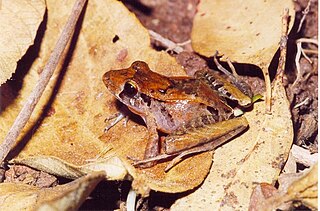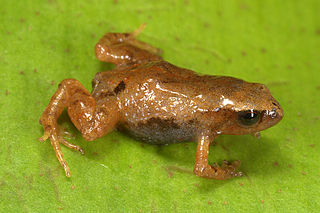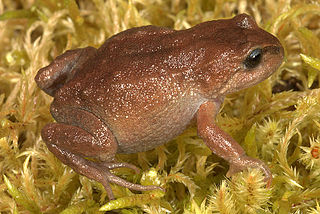
The saddleback toads (Brachycephalus) are a genus of tiny toads and frogs in the family Brachycephalidae in the order Anura, ranging from south Bahia to Santa Catarina in southeastern Brazil. The genus includes two main groups, the often brightly coloured pumpkin toadlets, and the overall brown and more frog-like flea frogs, which once were placed in their own genus Psyllophryne. Some pumpkin toadlets are toxic and their often bright colours are considered aposematic. At about 1 cm (0.4 in) or less in snout–to–vent length, the flea frogs are some of the smallest frogs in the world.

The Brachycephalidae are a family of frogs confined to eastern and southern Brazil and northern Argentina. The family is composed of two externally quite different genera: the tiny, often colourful and plump saddleback toads (Brachycephalus) from Brazil, and the larger, slimmer and more drab genus Ischnocnema from both Brazil and Argentina. The family is mainly defined by molecular characteristics, and are linked by few anatomical features. It was erected from two genera of the previously large family Eleutherodactylidae, which is now split into four families.

Nyctimantis is a genus of frogs in the family Hylidae. The genus is found in south-eastern Brazil as well as in the Orinoco Basin in Venezuela, Colombia, and Brazil. These are tree-dwelling species usually hiding in the cisterns of epiphytic bromeliads. The top of the head carries a bony plate which is fused with the skin.

Barycholos, common name Chimbo frogs, is a genus of small frogs in the family Strabomantidae found in south-eastern Brazil and tropical lowland Ecuador. The name Barycholos, from the Greek βαρύχολος ("savage"), is in honor of herpetologist Jay M. Savage.
Mount Duida frogs (Dischidodactylus) form a genus of brachycephaloid frogs endemic to the tepuis of southern Venezuela. The scientific name is derived from the Greek dischidos, meaning divided, and dactylos, meaning finger or toe, in reference to the divided ungual flap.

Euparkerella, sometimes known as Guanabara frogs, is a genus of frogs in the family Strabomantidae. They are endemic to the Atlantic coastal forests in the south-eastern Brazilian states of Espírito Santo and Rio de Janeiro. The name Euparkerella honours H. W. Parker, a herpetologist who named the type species, with the Greek prefix eu meaning true and suffix ella, a diminutive form.

Ischnocnema is a genus of frogs from eastern Brazil and north-eastern Argentina. They comprise the former Eleutherodactylus from this region, but they are closer to Brachycephalus than the "true" Eleutherodactylus. Consequently, they are now placed in their own genus Ischnocnema in the family Brachycephalidae.

Phrynopus is a genus of frogs of the family Strabomantidae. Their common name is Andes frogs. They are endemic to Peru and inhabit the upper humid montane forest and supra-treeline grassland in the Cordillera Oriental, with one record from the Peruvian Cordillera Occidental.

Oreobates is a genus of frogs in the family Strabomantidae. Most species were formerly in the genus Ischnocnema, but were moved to this revalidated genus following a 2006 revision. Its sister taxon is Lynchius.
Niceforonia nana is a species of frog in the family Strabomantidae. It is endemic to the Cordillera Oriental, Colombia, and found at 3,000–3,850 m (9,840–12,630 ft) asl.

The Strabomantidae are a family of frogs native to South America. These frogs lack a free-living larval stage and hatch directly into miniature "froglets". This family includes Pristimantis, the most speciose genus of any vertebrate.

Bryophryne is a genus of frogs in the family Strabomantidae. These frogs are endemic to south-eastern Peru in the Cusco Region, with an undescribed species from the Puno Region. Their range is separated from that of Phrynopus by the Apurímac River valley.

Craugastoridae, commonly known as fleshbelly frogs, is a family of New World direct-developing frogs. As delineated here, following the Amphibian Species of the World, it contains 129 species. They are found from the southern United States southwards to Central and South America.

Lynchius is a genus of frogs in the family Strabomantidae. The name honours herpetologist John D. Lynch. The distribution of Lynchius is restricted to the Cordillera Oriental in southern Ecuador and Cordillera de Huancabamba in northern Peru.

Yunganastes is a small genus of frogs in the family Strabomantidae found in southern Peru and central to northern Bolivia. They were formerly placed in the genus Eleutherodactylus as the "Eleutherodactylus fraudator group", subsequently moved to Pristimantis, before becoming recognized as a separate subgenus, and finally, a genus. Its sister taxon is the genus Pristimantis. Yunganastes are endemic to the cloud forests and humid montane forests of the Cordillera Oriental of the Andes in Bolivia and southern Peru.

Psychrophrynella is a genus of frogs in the family Strabomantidae The genus is distributed on the Andes of southern Peru and Bolivia. One of the four species assessed by the International Union for Conservation of Nature (IUCN) is assessed as "Critically Endangered".

Niceforonia is a genus of frogs in the family Strabomantidae found in northern South America. The name refers to Nicéforo María, Colombian herpetologist.

Noblella is a genus of frogs in the family Strabomantidae. They are found on the eastern slopes of the Andes and in the Amazon Basin in Colombia, Ecuador, Peru, Bolivia, and western Brazil. The name refers to Gladwyn K. Noble, who described the first species.

Psychrophrynella usurpator is a species of frogs in the family Strabomantidae. It is endemic to Peru and known from near Abra Acjanacu, a mountain pass in the Cordillera de Paucartambo, the easternmost Andean range towards the Amazonian lowlands, and from the high elevation grasslands of the Manu National Park. It is named usurpator because these frogs were previously misidentified as Noblella peruviana—in a sense, they had "usurped" the name of another frog species.
Brachycephaloidea (Terrarana) is a monophyletic group of frogs that includes the families: Brachycephalidae, Caligophrynidae, Craugastoridae, Eleutherodactylidae, Ceuthomantidae, Neblinaphrynidae and Strabomantidae. The superfamily contains 882 species that inhabit the New World tropics, subtropics, and Andean regions. The group has undergone extensive changes in its taxonomy thanks to multiple molecular phylogenetic analyses in recent years. Until 2008, these species were placed in a single, large family (Brachycephalidae) new analysis from 344 species were used to estimate their relationship. A new taxon name, Terrarana, including the same families is sometimes used.















